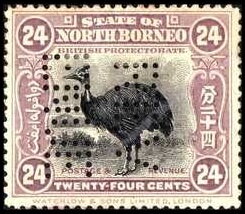Stamp: Dwarf Cassowary (Casuarius casuarius) (North Borneo 1914)
Dwarf Cassowary (Casuarius casuarius) (North Borneo 1914)
01 January (North Borneo ) within release Revenue goes into circulation Stamp Dwarf Cassowary (Casuarius casuarius) face value 24 British North Borneo cent
Stamp is square format.
Postage stamp of 1909 with perfin "REV ENUE" Perforation can vary between 13½ and 14 on this stamp due to variations in the perforating machinery used by the printer. Revenue Reverend cat. no: R43Also in the issue Revenue:
- Stamp - Asian Elephant (Elephas maximus) face value 5;
- Stamp - Asian Tapir (Tapirus indicus) face value 1;
- Stamp - Banteng (Bibos sondaicus) face value 20;
- Stamp - Coat of Arms face value 25;
- Stamp - Coat of Arms face value 50;
- Stamp - Coat of Arms face value 1;
- Stamp - Coat of Arms face value 2;
- Stamp - Coat of Arms with Supporters face value 5;
- Stamp - Coat of Arms with Supporters face value 10;
- Stamp - Dwarf Cassowary (Casuarius casuarius) face value 24;
- Stamp - Javan Warty Pig (Sus verrucosus) face value 10;
- Stamp - Palm Cockatoo (Probosciger aterrimus) face value 12;
- Stamp - Signing Treaty with Sultan of Sulu, 1881 face value 4;
Stamp Dwarf Cassowary (Casuarius casuarius) it reflects the thematic directions:
Animals are multicellular, eukaryotic organisms of the kingdom Animalia (also called Metazoa). All animals are motile, meaning they can move spontaneously and independently, at some point in their lives. Their body plan eventually becomes fixed as they develop, although some undergo a process of metamorphosis later on in their lives. All animals are heterotrophs: they must ingest other organisms or their products for sustenance.
Birds (Aves), a subgroup of Reptiles, are the last living examples of Dinosaurs. They are a group of endothermic vertebrates, characterised by feathers, toothless beaked jaws, the laying of hard-shelled eggs, a high metabolic rate, a four-chambered heart, and a strong yet lightweight skeleton. Birds live worldwide and range in size from the 5 cm (2 in) bee hummingbird to the 2.75 m (9 ft) ostrich. They rank as the class of tetrapods with the most living species, at approximately ten thousand, with more than half of these being passerines, sometimes known as perching birds. Birds are the closest living relatives of crocodilians.


